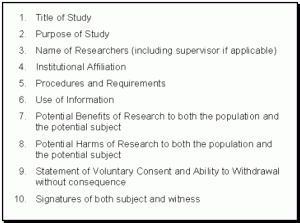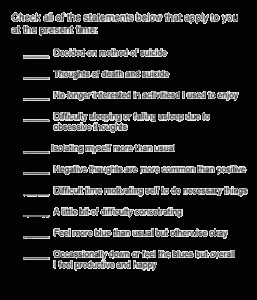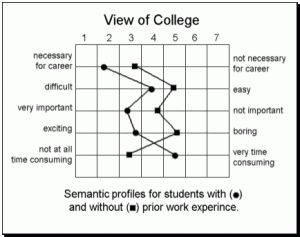Chapter 3.3 Software Tools of Research
Software Tools of Research
The software tools of research are typically more abundant than hardware tools in the social sciences. Software is usually thought of to mean computer programs that tell the hardware what to do, but any tool not related to a physical device can be considered software. Included in this category is statistical software, consent forms, published tests, questionnaires, observation forms, and, to a lesser degree, the interview.
Statistical Software. Simple statistical problems, such as determining the mean or the median of a small data set, can easily be done with a calculator. Most formulas that will be used in a research report, however, are a lot more complex. While a calculator will work, a statistical program can reduce the computation time by hours, days, or even weeks. Imagine trying to determine the mean, standard deviation, t-score, and z-score conversions of twelve data sets each containing 300 subjects. Even the best statistician will spend many hours on this project that could be done by a computer in a matter of minutes once the data is entered.
The most widely used statistical software used for social science research is the Statistical Package for the Social Sciences (SPSS) and is relatively easy to use if you have basic computer knowledge. SPSS can perform hundreds of statistical computations and even graph your data. Another program, SAS, also performs these functions and is gaining popularity with many researchers. Both, however, can be expensive to purchase so it would be wise to use your school’s software or look into a student version.
Consent Forms. The consent form is a necessity for anyone doing research with human subjects (see Figure 3.1). The purpose of the consent form is to provide information to the potential subject regarding the experiment or study and to answer questions regarding their participation. Consent forms should always include both potential benefits and harm that may result from participation as well as the option to quit the study at any time without repercussions.
Table 3.1 lists ten important areas that should be included in a consent form. The title of the study, purpose, and researchers’ names and affiliation are often included toward the top of the form. Contact information, such as phone numbers, should also be included. The bulk of the consent form involves the specific procedures that will be used, how the information gathered during the study will be used, and the expected experience that the subject will endure if he or she agrees to participate.
Procedures and Requirements. Before a potential subject can consent to any study, especially those involving invasive techniques, he or she must be made aware of the process that will take place. The procedures and requirements section explains to the subject what he or she will experience during the study. If a survey is involved, this section might inform the subject that they will be asked to respond to questions related to their past work experience or their college grades, for example.
Figure 3.1: Sample Statement of Informed Consent
Statement of Voluntary Consent
To participate as a subject in the study described below
Date: January 14, 2004
Name of Study: The effects of work experience on college performance
Purpose of Study: To better understand the role of work experience and college performance and to make recommendations to the college administration regarding the college work study program.
Primary Researcher(s): Dr. Christopher L. Heffner, [Affiliation]
Contact Information: [Include office phone, school or organization address, and information regarding any committees on ethical research within your organization]
As a volunteer participant in the above mentioned research, I understand that I will be asked to complete a survey that will ask questions related to my work experience and college grades. The survey typically takes about 20 minutes to complete although this time can vary depending on each subject. I also understand that I may consider some of the questions personal in nature but that the information I provide will be used exclusively for this project and will in no way be associated with my name, address, student ID or any other identifiable information.
As a participant in this study I am aware that the questions on the research survey may cause anxiety or stress depending on my personal situation but that most find the experience harmless and even enjoyable. As a participant, I am aware that the responses I provide may assist future college students at this University and perhaps other colleges across the country.
By signing below, I state that I have read this consent form in its entirety and that all of my questions have been answered. I understand that I may withdrawal from this study at any time and that my participation or lack of participation will in no way affect my status as a [student, patient, employee, etc.]
Subject Signature ________________________ Date ______
Witness Signature ________________________ Date ______
Use of Information. Whenever research is done, information is gathered. This information can be relatively innocuous such as hair color, gender, or number of siblings or it can be quite personal such as sexual history, views on abortion, or yearly income. No matter what information is collected, the subject has the right to know how this information will be used. Often times this section states that subjects are assigned a number and that no personal information will be associated with their identifiable information such as name, address, phone number or other characteristic that distinguishes them from others. In this situation, we would then know that subject number 14 is a female who is pro-life, and earns $35,000 per year, for example, but we wouldn’t be able to identify her.
Table 3.1: Checklist for the Statement of Informed Consent
Potential Benefits. There are often potential benefits to any study for the individual subject and should always be potential benefits to the population at large. This section allows the researcher to make statement such as, “the results of this research could lead to better teaching methods that may ultimately improve the way children learn.” Benefits to the potential subject should also be stated, such as free medication and treatment for a medical study, or consultation with a psychologist. Even something as simple as self-growth could be included in this section.
Potential Harms. Perhaps, more important than benefits, are the potential harms that could result from participating in the study. The subject must be informed of any risks involved, including both physical and emotional. Even if these potential harms are rare or farfetched, the subject has the right to know before consenting to participate. Often you will see statements that discuss the possibility of negative thoughts or feelings associated with the subject’s responses or actions. For example, a study addressing depression after the death of a loved on could easily bring about sad thoughts and depressed feelings as the subject answers questions related to his or her experience. If this is a possibility, it should be addressed in the consent form.
Statement of Voluntary Consent. The statement of voluntary consent typically contains two main statements. First, the subject will be agreeing that he or she has (a) read this form, (b) understand the form, and (c) has had all questioned answered. Second, the subject should be informed that he or she can drop out of the study at any point (if this is feasible without causing harm) without repercussions. This means that at any point from signing the form to the completion of the study, they could refuse to continue being a subject and will not be harassed, humiliated, or otherwise coerced.
Published Standardized Tests. Often researchers want to gather information related to a general area such as personality or intelligence. For these instances, the use of a standardized test may be the best choice. With already published tests you can be sure of both validity and reliability and can save a lot of time that might otherwise be spent on test construction. Standardized tests can be classified into five main categories: achievement, aptitude, interest, personality, and intelligence.
Achievement Tests. Achievement tests are designed specifically to measure an individual’s previously learned knowledge or ability. They are available for many topic areas related to psychology, education, business, and other fields. Achievement tests require that prior learning take place and that this learning be demonstrated in order to pass.
Aptitude Tests. Aptitude tests attempt to predict an individual’s performance in some activity at some point in the future. They do not require any specific prior learning although basic knowledge related to reading and writing is usually required and some preparation, such as studying up on math formulas or sentence structure, can be helpful. A well-known example of this type is the Scholastic Achievement Test (SAT), designed to predict future college performance.
Interest Inventories. Interest inventories also require only general knowledge but no preparation is needed. These tests look at an individual’s subjective interests in order to make predictions about some future behavior or activity. Perhaps the most used interest inventory is the Strong Interest Inventory, which compares interests related to specific careers in order to help guide an individual’s career path. Endorsed interests are compared with the interests of successful individuals in various fields and predictions are made regarding the test-taker’s fit with the various career fields.
Personality Tests. Typically designed to assess and diagnose personality and mental health related disorders, personality tests are used extensively by psychologists in clinical, educational, and business related settings. By far the most widely used test of this type is the Minnesota Multiphasic Personality Inventory, Second Edition (MMPI-2), which compares an individual’s responses on a series of true-false items to those suffering from various mental disorders such as depression, schizophrenia, and anxiety. The theory behind the test argues that if you endorse items similar to the items endorsed by those with depression, for example, then the chances that you are also depressed increases.
Intelligence Tests. Intelligence tests could be classified as aptitude tests since they are sometimes used to predict future performance. They could also be classified as personality tests since they can be used to diagnose disorders such as learning disabilities and mental retardation. However, because of their limited scope, we will place them in their own category. The purpose of an intelligence test is to attain a summary score or intelligence quotient (IQ) of an individual’s intellectual ability. Scores are compared to each other and can be broken down into different subcategories depending on the intelligence test used. The most commonly used tests of this type are the Wechsler Scales, including the Wechsler Adult Intelligence Scale (WAIS), the Wechsler Intelligence Scale for Children (WISC), and the Wechsler Preschool and Primary Scale of Intelligence (WPPSI).
Self-Response Questionnaires. Self-response questionnaires are a great way to gather large amounts of information in a relatively short amount of time. A questionnaire, similar to a survey you might see on a web page, allows subjects to respond to questions, rate responses, or offer opinions. Their responses can then be used to place them in specific categories or groups or can be compared to other subjects for data analysis. A concern with self-report, however, is the accuracy of the responses. Unlike direct observation, there is no way of knowing if the subject has told the truth or whether or not the question was understood as intended. There are several different methods for gathering information on a questionnaire or survey, including a Likert scale, the Thurstone technique, and the semantic differential.
Likert Scale. The Likert scale is a popular method used ion surveys because it allows the researcher to quantify opinion based items. Questions are typically grouped together and rated or responded to based on a five-point scale. This scale typically ranges in order from one extreme to the other, such as (1) very interested; (2) somewhat interested; (3) unsure; (4) not very interested; and (5) not interested at all. Items that might be rated with this scale representing the subject’s level of interest could include a list of careers or academic majors, for example. Table 3.2 lists some examples of a five-point Likert Scale.
Table 3.2: Examples of Five-point Likert Scales
Thurstone Technique. The Thurstone technique allows subjects to express their beliefs or opinions by checking items that apply to them. It requires that a series of statements, usually 10 or 20, be created by experts in a specific area of interest. These statements are placed in order of intensity or rated in order of intensity by the experts. The subject is then asked to check all of the statements that apply to her and a median score is computed based on which items she has checked. For example, if the subject checked three items that were rated an intensity of four and three items rated an intensity of two, her median score would be 3. The subject who checked higher rated items would receive a higher median score and the subject who checked lower level items would receive a lower median score. Table 3.3 provides a hypothetical Thurstone scale for major depressive disorder with the symptoms starting at the bottom representing low intensity and then progressing upward to the top, which represents high intensity.
Table 3.3: Sample Thurstone Questionnaire
Semantic Differential. Somewhat similar to a likert scale, a semantic questionnaire asks subjects to rate their opinion on a scale representing two extremes and a series of points in between. Unlike the Likert, however, this technique usually provides a total of seven points rather than five, and the points in between the extremes are not labeled. The subject is therefore forced to provide his own rating on a ‘one to seven’ scale only knowing the description of the two extremes. Good examples of these semantic differentials include dichotomies such as extroverted/introverted, friendly/cruel, interested/not interested, or biological/environmental. Figure 3.2 provides an example of what the results of research might look like using a semantic differential technique.
Figure 3.2: Research Results of a Hypothetical Semantic Differential Scale
Observation Forms. Observation of subjects has been a longstanding means of gathering information. While this method works well for informal research or research involving only a single subject, it is not an easy task to generalize to the greater population. Scientific methods require that any observation be as standardized and objective as possible if generalization is to occur. Observation forms are often used to allow researchers to detail their observations on an agreed upon scale and observer ratings are often correlated to determine if all are measuring the same behaviors.
Human behavior is complex and measuring it merely by watching behaviors presents unique challenges. Imagine measuring violent behavior is a group of 3rd graders during recess. What one observer sees as violent, pushing another child for example, a second researcher may view as aggressive but not violent. A third observer may miss the behavior all together due to other behaviors or some distracter on the playground. To increase validity and reliability, the following steps are recommended:
1. Operationally define behaviors to be observed as much as possible
2. Practice observations before the study to correlate results in order to make sure all observers are measuring the same behaviors
3. Use at least two observers per subject when possible in order to minimize missed behaviors or misinterpretations
4. Retrain observers frequently and correlate these training observations.
Q-Sort. The Q-Sort is a technique adopted originally into humanistic psychology as a means for a client to self-evaluate his current status and then decide on treatment goals. Since the instrument is completed and interpreted by the client without the opinion of the therapist, it allows the client to be in complete control of what issues are to be worked on. This follows the humanistic view that the client, not the therapist, is the one with the answers to the client’s problems.
The Q-Sort consists of a number of cards, often as many as 40 or 50, each consisting of a single trait, belief, or behavior. The goal is to sort these cards into one of five columns ranging from statements such as, ‘very much like me’ to ‘not at all like me.’ There are typically a specific number of cards allowed for each column, forcing the client to balance the cards evenly. The qualities in each column are then recorded and the results are used to assist the client in determining issues he or she wishes to work on in treatment. The Q-Sort can also be completed during and after treatment to assess changes and progress toward the self-determined goals.

Figure 3.3: Sample Outcome of a Q-Sort
The Interview. The interview is a well-known means of gathering information, especially in organizational settings such as hiring employees or gathering background information. Just like observations, interviews can be very subjective. It is therefore important to determine questions prior to the study and to develop a protocol that will be followed by all interviewers. This protocol will ask the same questions in the same order to every subject and responses should be recorded exactly. It is also helpful if possible responses to questions are kept as closed ended as possible. For example, “how many siblings do you have?” rather than “tell me about your siblings.”
What makes the interview different than a self-administered questionnaire is the ability to judge behaviors, and to inspire or clarify responses. Interviews can be time consuming, especially if a large number of subjects are to be interviewed. And, if open-ended questions are used, the quantitative procedures of statistics become much more difficult.




